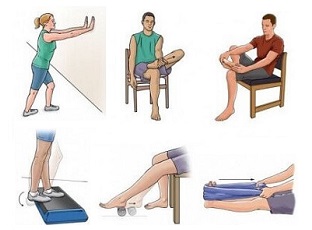- Home
- Anatomy Guide
- Soleus
Soleus Muscle
Written By: Chloe Wilson BSc(Hons) Physiotherapy
Reviewed By: FPE Medical Review Board
Muscle Group: Soleus is the deepest of the two calf muscles, found on the back of the lower leg
Action: Ankle plantarflexion
Origin: Posterior surfaces of the tibia and fibula, and fibrous arch
Insertion: Posterior surface of the calcaneus (heel bone) via the Achilles tendon
Nerve Supply: Tibial Nerve (S1, S2)
Functions: Standing on tiptoes, stops the body falling forwards when standing and aids blood flow
Potential Problems: Muscle strain, calf injuries
Soleus Muscle Anatomy
The soleus muscle is the deeper or the two calf muscles, found underneath the gastrocnemius muscle on the back of the lower leg. As well as plantarflexing the ankle, soleus also plays an important role in maintaining posture.
It is a powerful, broad, flat muscle, originating from the soleal line on the posterior surface of the tibia, the posterior surface of the upper third of the fibula, including the head, and a fibrous arch that sits between these bony attachments.
The muscle fibres of soleus pass downwards forming a muscle belly about half way down the calf. It then narrows and forms a tendon which combines with the tendon of gastrocnemius to form the tendocalcaneus, more commonly known as the Achilles tendon. The tendon passes behind the back of the ankle joint and inserts into the middle part of the posterior surface of the calcaneus.
What Does Soleus Do?
The soleus muscle plays a vital role in posture and balance, working when we stand to prevent the body falling forwards at the ankle.
It also works as a skeletal muscle pump, known as the soleal or sural pump. The muscle contracts intermittently when standing which helps to pump venous blood back up to the heart from the lower leg/foot.
Soleus and gastrocnemius are the two main plantarflexors of the foot, the movement where the toes point down or when we stand on tiptoes. Soleus is the most effective plantarflexor when the knee is bent.
A majority of its muscle fibres are red, slow twitch fibres allowing it to resist fatigue. Soleus tends to do a majority of plantarflexion with regular activities such as walking whereas gastrocnemius takes over when propulsive forces are needed such as with running and jumping.
The Achilles tendon is the thickest and strongest tendon in the body and is thought to be able to withstand strains of up to 10 tons. As the fibres of the achilles pass downwards, they spiral through 90 degrees with the medial fibres passing posteriorly and it is this unusual arrangement that is thought to give the tendon its elastic qualities for example when jumping and running.
Calf Problems & Treatment
Calf injuries are a common problem, particularly in runners. The most common calf injuries are :
- Achilles Tendonitis: A common problem causing pain at the bottom of the calf - find out about the causes, symptoms and treatment options
- Calf Tear: Over-stretching or over-working the calf muscles can lead to tears in the muscle fibres such as a soleus strain. Find out all about pulled calf muscles on our sister site
What Can Help?
If you have suffered from a calf strain or other calf injury, these articles will help you make a full recovery:
- Diagnosing Calf Pain: Suffering with calf, ankle of foot pain. Use our diagnosis guide to work out what might be wrong
- Calf Stretches: Find out how to stretch the calf muscles as a pair or separately
- Calf Strengthening: Some great exercises to build up the strength and endurance of your calves - say no to cankles!
You can also find out about the Soleus muscle's partner gastrocnemius and how it works.
Related Articles
Page Last Updated: 10/05/22
Next Review Due: 10/05/24




